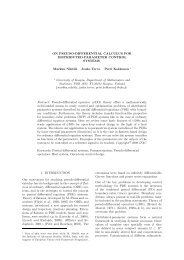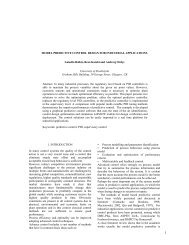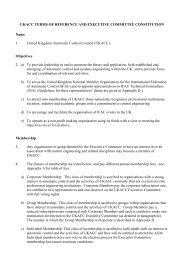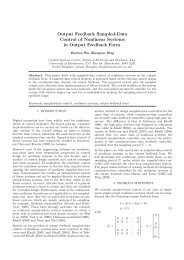SLIDING-MODE POSITION CONTROL OF A 1-DOF SET-UP BASED ...
SLIDING-MODE POSITION CONTROL OF A 1-DOF SET-UP BASED ...
SLIDING-MODE POSITION CONTROL OF A 1-DOF SET-UP BASED ...
Create successful ePaper yourself
Turn your PDF publications into a flip-book with our unique Google optimized e-Paper software.
<strong>SLIDING</strong>-<strong>MODE</strong> <strong>POSITION</strong> <strong>CONTROL</strong> <strong>OF</strong> A 1-D<strong>OF</strong> <strong>SET</strong>-<strong>UP</strong> <strong>BASED</strong> ON PNEUMATIC MUSCLESJ. Arenas, A. Pujana-Arrese, S. Riaño, A. Martinez-Esnaola and J. LandaluzeIKERLAN Technological Research CenterControl Engineering and Power Electronics DepartmentArizmendiarrieta, 2. E-20500 Arrasate/Mondragon, SpainE-mail: JArenas@ikerlan.es. Phone: +34-943712400Abstract: A one-degree-of-freedom arm driven by pneumatic muscles has been designedand built in order to research the applicability of pneumatic artificial muscles in industrialapplications. The experimental set-up is very non-linear and very difficult to controlproperly. As a reference, an enhanced PID controller was designed. At the same time, asliding-mode controller based on an observer was designed and implemented. Firstly, thispaper presents the experimental set-up and the system’s linear models. After that, it focuseson the process of designing the sliding-mode controller. Finally, some results obtained insimulation as well as experimentally are presented. Copyright © 2008 IFACKeywords: Pneumatic system, robot arm, sliding-mode control, PID control, robust control.1. INTRODUCTIONThe Ikerlan research centre is working on the designof an upper limb IAD (Intelligent Assist Device)(Martinez, et al., 2007), a wearable exoskeletonoriented to help the user perform a routine activity inthe workplace. One of the design specifications wasto use, if possible, non-conventional actuators.Between the different alternatives, pneumaticartificial muscles – or McKibben muscles – are veryinteresting. For the purpose of researching theirapplicability in this kind of applications, anexperimental one-DoF arm powered by pneumaticmuscles manufactured by Festo was designed andconstructed.The experimental set-up resulted to be very nonlinearand very difficult to control properly. Due tothe fact that the results obtained with a classical PIcontroller were not good, robust control techniqueswere considered. For pneumatic muscles, theapplication of different control techniques is found inthe literature, but a good performance requires theuse of robust or non-linear control techniques (Thanhand Ahn, 2006; Balasubramanian and Rattan, 2005).Therefore, a non-linear robust control technique,sliding-mode, was applied to design a positioncontroller. At the same time, and as a reference, aPID based controller was enhanced with linear andnon-linear internal loops. Previously, the set-up wasmodelled in Dymola/Modelica and validatedexperimentally (Pujana-Arrese, et al., 2007), andlinear models obtained.This paper focuses on the design of a sliding-modeposition controller for the one-DoF arm. Afterdescribing briefly the experimental set-up, this papergoes on to explain the control objectives and thenominal linear models used in the controller designprocess. Then, the sliding-mode design procedure andthe controller obtained are presented. The resultingchattering phenomenon and its compensation areshown as well. For purposes of comparison, thestructure of the enhanced PID controller is alsostated. Finally, the paper concludes by presentingsome experimental and in-simulation results.2. EXPERIMENTAL <strong>SET</strong>-<strong>UP</strong>A real picture of the set-up constructed can be seen inFigure 1, where two DMSP-20-200N pneumaticmuscles manufactured by Festo perform the role ofthe actuator. It consists of a robotic arm, with adisplacement of around 60º and a maximum mass tobe moved at the tip of 8 kg. The arm mass is 0.987 kgand, considering that the arm is in the horizontal
RotaryencoderFig. 2. Linear transfer functions for 0, 3 and 6 kg.Load cellFig. 1. Picture of the experimental set-up.position, the centre of the arm mass with regard to thecentre of rotation is at a height of 17.6 mm and at ahorizontal distance of 205 mm. The additional massesare placed on the end of the arm at a horizontal lengthof 367 mm with regard to the centre of rotation. Theset-up may be rotated so that the arm moves in ahorizontal plane and the effects of gravity aretherefore cancelled out.A Festo MPYE-5-1/8HF pneumatic servovalve isused for actuation. The prototype includes a FAGORS-D90 encoder which supplies 180000 pulses perturn, and a load cell on the lower stop of the model. Amore in detail description can be found in (Pujana-Arrese, et al., 2007). Control algorithms wereimplemented in Simulink and code generated anddownloaded in the control hardware by means of twoof The MathWorks tools: RTW and xPCTarget.3. SYSTEM <strong>MODE</strong>LSFor the design of the robust controller the nominalconditions were considered to be when the roboticarm has a load of 3 kg at the tip, and that this loadmay be reduced, or increased up to 6 kg. Thespecifications therefore presume that the system mustbe robust for this load interval.A full non-linear model of the prototype,experimentally validated, had previously beendeveloped in Dymola/Modelica (Pujana-Arrese, etal., 2007). On the basis of this model, reduced linearmodels for use in designing controllers were deduced.The nominal model is taken as being with a weight of3 kg at the tip of the arm. Considering the system as aSISO system, where the input is the input voltage tothe servovalve and the output is the angle position ofthe robotic arm, the resulting transfer function of thenominal model is as follows:G3N3 220.2 s +31 s+175() s =0.075 s +0.426 s +9.36 s+0.003As extreme cases in the considered working range, itis contemplated a load of 6 kg at the tip of the arm,with the following reduced linear model:20.6 s+63.5G6 () s =4 3 20.008 s +0.09 s + s +5.26sand the case of there being no weight on the arm,where the linear model is:20.33 s +61.74 s+142.5G0 () s =5 4 3 20.00003 s +0.00153 s +0.058 s +1.96 s +5.98sFigure 2 shows the plants in the frequency domain.As can be observed, the models show significantresonance. When the load is increased, the resonancefrequency is reduced, together with the gain. Thedifferences between the linear models are consideredto be nominal model uncertainties. For purposes ofobtaining these linear models, the effect of gravityhas not been taken into account, as it was supposedthat the arm moved in the horizontal plane. Also,these linear models do not reflect the significantinfluence of friction, which is very differentthroughout the robotic arm’s range of displacement.The application of the pneumatic muscles is intendedfor a human arm orthosis, where the set-pointposition is generated by the user’s intention ofmovement, and it is not a path pre-set by a controller.On tuning the controller, small jumps in position, of10º, have therefore been contemplated. Theperformance specifications are that the response tothese jumps must be as quick as possible, with verylittle overshoot and no vibration.4. <strong>CONTROL</strong>LER DESIGN4.1 Brief review of sliding-mode theory consideredSliding Mode Control (SMC) is a special case ofVariable Structure Control (VSC). SMC techniqueshave been used in a diversity of systems due to theiradvantages as regards robustness in their applicationfor control of non-linear systems. The design
methodology entails dividing the problem into twosmaller-sized sub-problems: Firstly, establishing thesliding surface dynamics, which must be acceptableand may be linear, and then designing the surface thatgoverns the system’s behaviour when it is in slidingmode. A control law is subsequently designed,guaranteeing that the paths close to the slidingsurface lead to that surface.When the system is trapped on the surface, where thestructure and the parameters have been established bythe designer, the closed loop dynamics is totallydetermined by the equations that define it, and it isindependent from any disturbance of the systemparameters, thus achieving excellent robustness.To develop the controller, development fromEdwards and Spurgeon (1998) has been basicallytaken into account. A tracking requirement wasincorporated using an integral action approach.Initially, the following system is considered:xt &() = Axt () + But ()yt () = Cxt ()(1)which is assumed to be square, where A and B are thematrices representing the nominal system and x(t) isthe state vector. Considering an integral action,padditional states xr∈ R are introduced:x& () t = r () t − y () t(2)rwhere r(t) represents the set-point value and y(t) isthe system output. Taking this into account, the newstate vector is as follows:n= ⎡ x1⎢⎤x ⎥2x% (3)⎣ ⎦being x1∈ R the old state vector and x 2 =x rrepresents the additional states. In this way, theincreased nominal system can be rewritten as follows:x&1() t = A% 11x1() t + A%12x2() t + r()tx&() t = A% x () t + A%x () t + Bu()t2 21 1 22 2% %⎡1 2⎡A11 A12⎤= ⎢0A11 A ⎥⎢ 12A% 21A%⎣⎥22 ⎦ ⎢ ⎥0 A21 A22⎣0−C−C⎤⎦(4)(5)As previously explained, the sliding-mode control isbased on taking the system to a surface where theclosed loop dynamics will be governed by theequations established, free of any unmodelleddisturbances. In this way, bearing in mind that atracking requirement has been incorporated, thesliding surface is defined by:n+p{% R : %r }S = x∈ Sx = S r[ ]S = S S1 2(6)where S and S r are design parameters governing themovement dynamics. S 1 will be of dimension n, andS 2 of dimension p. It can be deduced from (4) that theideal sliding movement is given by:x& () t = ( A% − A% M) x () t + ( A%S S + I) r()t (7)−11 11 12 1 12 2 r−1where M = S2 S1. S must therefore be defined to setthe system dynamics on the sliding movement. Toestablish the sliding surface S the system’suncertainties must be taken into account, estimatedthrough the nominal models presented; to do this, arobust eigenstructure assignment was made, whichsets the actual values of the closed loop system bydesign, thus defining the sliding surface S.Once S has been set, the control signal for designinga sliding-mode controller including an integral actionapproach and a tracking requirement is:where the linear component is:u = u ( x% , r)+ u(8)LNu ( x% , r)= Lx% + L r + L & r& (9)L r r−[ ][ ]−1[ ]L =− SB ( SA%−φS)1−1r=− φr+2L SB ( S S M )L = SB Sr&and where S r and φ are design matrices.r(10)The non-linear component of the control law (8) willbe a function of the surface S, multiplied by a gain Kestablished in the design process. In classical slidingmodea sign function is used:4.2 Observer designuN =−K ⋅ sgn( Sx% ) (11)The design of the controller described above must beable to measure the state vector. However, this is notpossible in the physical system being studied, and anobserver therefore needed to be designed in order toestimate it. To do this, the approach followed by
Walcott and Zak (1987) is used, such as it is cited inEdwards and Spurgeon (1998).In a linear system such as (1), the observer can beexpressed by the formula:u+e-s K ffPID PI-+-K a+GravGyxt ˆ& () = Axt ˆ() + But () −GCxt ( ˆ() − yt ()) + FBν (12)sFilterswhere ˆx represents the state vector estimated. In thisway, the observer takes the form of a system model,which is impelled by the misalignment between theplant output and the observer output. The linear gainG is calculated as follows:G = T⎡A−1 120 ⎢ sA22 − A22⎣⎤⎥⎦(13)where T0is the matrix representing the change ofcoordinates between the given system and itsscanonical form and A22is a diagonal matrixestablished in the design. ν is the sign function ofCxˆ( t) − y()t multiplied by a design constant K. TheTmatrix F is calculated by means of F = B P, whereP is the solution to the Lyapunov equation:s s T22 2204.3 Controller implementationA P+ PA + I = (14)On the basis of the nominal model G 3N the first step isto convert the system given by a transfer function intoits expression by means of the state space, obtainingthe A, B and C matrices required for the design (seeAppendix). Once these matrices defining the systemhave been obtained, the next step is to design theobserver to obtain the matrices G and F. To do this,the valueA needs to be established. This was dones22by trial and error, setting the desired outputestimation error pole.After designing the observer, it was proceeded todesign the sliding-mode controller in accordance withthe equations described in the previous sections. Thedesired λ poles had to be set for the closed loopsystem, which provides the system robustness. Therest of the design matrices (see Appendix) were setexperimentally to obtain good response performance.4.4 Chattering compensationIn classical sliding-mode the equation (11) leads toundesirable phenomenon of oscillations, which isknown as “chattering”. It is a harmful phenomenonbecause it causes high controller activity and highheat losses in mechanical parts and power circuits.Several strategies for significantly reducing thisphenomenon can be found in the literature:Perruquetti and Barbot (2002) saturate the changingspeed of the sign function so that the non-linearcomponent of the control does not change sign in ansample time; another possibility, described by Utkin,et al. (1999), is to replace the sign function byanother function which remains invariable once thesliding within a band has been guaranteed, forexample s / φ , where φ is the boundary layerthickness; and a third alternative, very widely used,consists of replacing the sign function by the tanhfunction. The first of these methods has been used forthe case in hand.4.5 Enhanced PID based controllerInitially, a classic PI controller was adjusted so that itserved as a reference for comparing the resultsobtained with other, more advanced, controllers. Onthe basis of this basic controller, the structure wascompleted with other internal linear and non-linearloops. Figure 3 shows the structure of the mostelaborate controller constructed. The position PIDwas complemented with a speed loop and anacceleration loop. A speed feedforward was alsoadded to improve the dynamic response. A moreinternal non-linear loop partly compensated theeffects of gravity. For the basic PI controller the gainswere adjusted to the values K p =0.062 and K i =0.029.For the case of the enhanced PID the tuned gainswere K p =8.5, K i =0.009, K d =0.8, K vp =0.02, K vi =0.005,K ff =0.0025 and K a =0.0002.5.1 Results in simulationEnhanced PID based controllerFig. 3. Structure of the enhanced PID based control.5. RESULTSThe sliding-mode controller designed was previouslytested in simulation. As an example of the tuningperformed, Figure 4 shows the response of the linearsystem simulated to a 10º/s ramp, varying the setpointposition from 40º to 50º, the angle beingmeasured with respect to the vertical. The resultsshown are those obtained in three cases: with thenominal model of 3 kg at the tip, with a load of 6 kg
Fig. 4. Results in simulation.Fig. 6. Experimental results in lower zone.Fig. 5. Experimental results in the middle of zone.at the tip, and with 2 kg. The system response with 2and 3 kg shows a lesser upward slope time, althoughit finally exceeds the set-point value. When thisovershoot is compensated for, the error rapidlydecreases until it reaches zero. With 6 kg, the systemdoes not show any overshoot but the establishmenttime is longer. It could be underlined the fact that thesystem shows no vibration when the nominal load isincreased by 100%, thus proving the robustness ofthe sliding-mode controller. When the load isdecreased the performance is a bit worse.5.2 Experimental resultsBoth the sliding-mode controller and the enhancedPID presented were discretized with a sample time of2 ms. As in the PID controller, also for the slidingmodecontroller an internal loop was added whichpartly compensated the effects of gravity. Due to thesignificant effect of the non-linearities on themovement of the prototype throughout its entirerange, the results for two different areas are shown,comparing the responses obtained with the slidingmodecontroller to the responses for the PI and theenhanced PID. Figure 5, which corresponds to a jumpin the intermediate area of the displacement range,shows the experimental results obtained with theweight considered as nominal, 3 kg. It can be seenthat for the PI control response both the overshootand establishment time are excessive, while theresponse of the enhanced PID is suitably inaccordance with the set-point value until a vibrationFig. 7. Experimental results with different tip masses.occurs which changes its dynamics and worsens theestablishment time. The sliding-mode controller, withslight vibration in the overshoot area, is also veryfast, and cancels out the stationary error.Figure 6 shows the system’s response in the sameconditions as above, but in the area showing worseperformance: it corresponds to a jump at the end ofthe displacement range, when the arm moves intoquasi-horizontal position. Again, the PI control showsa response with considerable overshoot andestablishment time, in addition to vibration. On theother hand, it can be observed how the response ofthe improved PID substantially increases itsestablishment time with respect to the previous zone.The sliding-mode controller reaches the set-pointposition in less than one second, although thevibration in the overshoot area is increased withrespect to that occurring in the previous jump.To corroborate the robustness of the sliding-modecontroller, Figure 7 shows the response of the armwith a load of 2, 3 and 6 kg to a set-point positionchange of 40º (the 0º reference corresponds to thevertical position). In all the cases, the responses showgood establishment times, although, as anticipated onsimulation and as a result of the tuning performed,overshoot occurred in the test carried out with 2 and3 kg. In any case, the robustness of the sliding-modecontrol is evident, as the differences between theresponses are very slight.
Fig. 8. Chattering effect in the control signal.As mentioned in section 4.4, the chatteringphenomenon must be taken into account in the designof the sliding-mode controller, attempting to reduceit. With this object in mind, the saturation to the nonlinearcontrol component was implemented, limitingthe speed at which it can change the sign function to10º/s. Figure 8 shows the control signal for the testshown in Figure 7 in the case of 3 kg, with no antichatteringstrategy being used. Much high-frequencyactivity can be observed. Figure 9 shows the controlsignal for the same case, but using the anti-chatteringstrategy described. The system’s response in bothcases is totally identical, with no loss of performance.6. CONCLUSIONSThis paper presents the design of a sliding-modeposition controller for an experimental one-DoFprototype based on pneumatic muscles. Theprototype is very non-linear according to thedisplacement zones, and very difficult to control witha classical PI type controller. Observer-based designwas used for the sliding-mode position control, andthe controller obtained proved to be robust as regardsperformance. Also, as a reference for comparing theresults, an improved PID controller with linear andnon-linear loops was considered. The data presentedshow the superiority of the sliding-mode controller.ACKNOWLEDGMENTThe material used in this paper was partly supportedby the Spanish Ministry of Education and Scienceand European FEDER Fund (research projectDPI2006-14928-C02-01).REFERENCESBalasubramanian, K. and K.S. Rattan (2005). Trajectorytracking control of a pneumatic muscle system usingfuzzy logic. NAFIP’2005, Annual Meeting of the NorthAmerican Fuzzy Information Precessing Society.Martinez, F., I. Retolaza, E. Lecue, J. Basurko and J.Landaluze (2007). Preliminary design of an upper limbIAD (Intelligent Assist Device). 9th EuropeanConference for the Advancement of AssistiveTechnology, AAATE 2007, October 3rd-5 th , Donostia.Fig. 9. Control signal with anti-chattering algorithm.Pujana-Arrese, A., J. Arenas, L. Maruri, A. Martinez-Esnaola and J. Landaluze (2007). Modelling andValidation of a 1-D<strong>OF</strong> Arm Powered by PneumaticMuscles. Industrial Simulation Conference ISC’2007.11-13 June, Delft, Holland.Thanh, T.D.C., and K.K. Ahn (2006). Nonlinear PIDcontrol to improve the control performance of 2 axespneumatic artificial muscle manipulator using neuralnetwork. Mechatronics, no. 16, pp. 577-587.Edward, C. and S.K. Spurgeon (1998). Sliding ModeControl. Theory and Applications. Taylor & FrancisLtd. ISBN 0-7484-0601-8.Perruquetti, W. and J.P. Barbot (2002). Sliding ModeControl in Engineering. Marcel Dekker, Inc. ISBN 0-8247-0671-4.Utkin, V., J. Guldner and J. Shi, J (1999). Sliding ModeControl in Electromechanical Systems. Taylor &Francis. ISBN 0-7484-0116-4.Walcott, B.L. and S.H. Zak (1987). State observation ofnonlinear uncertain dynamical systems. IEEETransaction on Automatic Control, no.32, pp.166-170.APPENDIXThe design values used in equations (1), (6), (9), (10)and (12) are as follows:⎡ ⎤ ⎡ ⎤⎢ ⎥ ⎢ ⎥⎢ ⎥ ⎢ ⎥⎣ ⎦ ⎣ ⎦−5.7176 −125.6904 −0.0044 1A = 1 0 0 ; B = 00 1 0 0C =[ 2.9 415.3 2350]S = ⎡⎣0 −1 −9.28 − 33.64⎤⎦L = 0 −23.5624 93.5496 −672.7956[ ]Lr= 0.2863 ; Lr&= 0.0143Sr=− 0.0143 ; P = 0.025φ =− 0.2 ; K = 0.02⎡−1.9609⎤G = ⎢ 0.3491 ⎥⎢ ⎥⎣ 0 ⎦F = 14.3243K (obs) = -2








